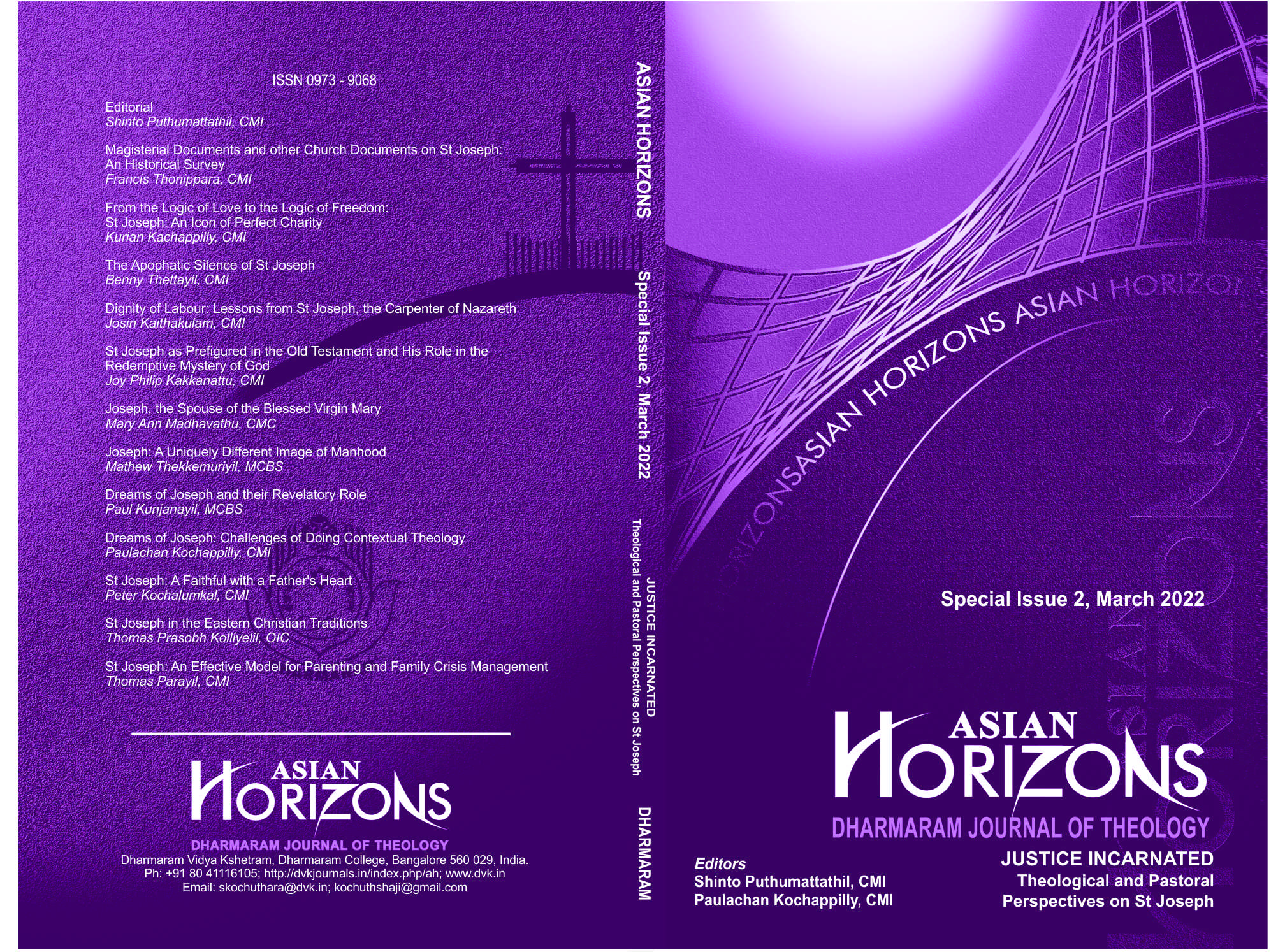FROM THE LOGIC OF LOVE TO THE LOGIC OF FREEDOM: ST JOSEPH - AN ICON OF PERFECT CHARITY
Keywords:
Fiat, Freedom, Justice, Love, Relationship, ResponsibilityAbstract
“The logic of love is always the logic of freedom” (Patris Corde, 7). For, as St John in his Epistle (I Jn 4:18) testifies, “[…] perfect love casts out fear.” Love, freed from fear, dares for what is seemingly impossible. The very life of St Joseph is an epitome of what Pope Francis calls “creative courage” and “love with extraordinary freedom.” This extraordinary courage and freedom dared St. Joseph, on the one hand, to recognize ‘the not-yet’ dimensions of the loving relationship with Mama Mary and Child Jesus, and, on the other, to accept the unknown risks in their future course of life. With authentic freedom, St. Joseph said ‘fiat’ to God’s will, as revealed to him in the Law (Lk 2:22.27.39) and through the dreams (Mt 1:20; 2:13.19.22). He could, therefore, own the responsibilities of his decisions and bear the consequences of his actions. Thus St Joseph proved himself a “just man” who could transcend the “norms of right order” (justice), and serve Mary and Jesus with “extraordinary freedom” derived from “the logic of love.”
References
Andreas Capellanus, The Art of Courtly Love, New York: Columbia University Press, 1941, 74.
Aristotle, Magna Moralia, in The Complete Works of Aristotle, ed., Jonathan Barnes, New Jersey: Princeton University Press, 1984, 1210b, 10.
Aristotle, Nicomachean Ethics, trans. Hippocrats G. Apostle, London: Redial Publishing, London, 1980, Book E, 5.
Bernard Häring, Free and Faithful in Christ, New York: Seabury Press, 1978, 471.
Charles Hartshorne, “Love and Light” (Unpublished), Sermon in the Federated Theological Schools, Bond Chapel, 1950, 2.
Charles Hartshorne, Man’s Vision of God and the Logic of Theism, Hamden: Archon Books, 1964, ix.
Charles Hartshorne, Philosophers Speak of God, Chicago: University of Chicago Press, 1953, 110.
Daniel Williams, The Spirit and Forms of Love, Lanham: University Press of America, 1981, 116.
E.H. Gombrich, Symbolic Images, London: Phaidon, 1972, 127.
Eric Fromm, The Art of Loving, New York: Random House, 1956, 57.
Geoffrey Chaucer, The Works of Geoffrey Chaucer, ed. F.N. Robinson, London: Oxford University Press, 1966, Line 1744.
George Bernard Shaw, Man and Superman: Maxims for Revolutionaries, London: 1903, 61.
Here I follow the line of arguments, which I have developed in my book, Kurian Kachappilly, God of Love: A Neoclassical Enquiry, 50-53.
Hobbes, Leviathan, 64-65.
Immanuel Kant, Critique of Practical Reason, trans. T.K. Abbott, London: Longmans, 1923, 176.
Immanuel Kant, Kants Gesammelte Schriften, ed., Berlin: Georg Reimer, 1900, 429.
Jean Paul Sartre, Being and Nothingness, trans. Hazel Barnes, London: Routledge, 1991, 47ff.
Jean Paul Sartre, Existentialism and Human Emotions, New York: Philosophical Library, 1957, 46: “Those who hide their complete freedom from themselves out of a spirit of seriousness or by means of deterministic excuses, I shall call cowards; those who try to show that their existence was necessary, when it is the very contingency of man’s appearance on earth, I shall call stinkers.”
Jean Paul Sartre, Existentialism and Humanism, trans. Philip Mairet, London: Methuen, 1948, 34.
John Macquarrie, In Search of Humanity, London: SCM Press, 1982, 180.
Kurian Kachappilly, God of Love: A Neoclassical Enquiry, Bangalore: Dharmaram Publications, 2002, 46.
Mahatma Gandhi, Collected Works, New Delhi: Motilal Publications, 1964, Vol. 3, 231.
Martin Heidegger, Being and Time, trans., John Macquarrie, New York: Harper, 1962, 296-99.
Mary Joseph Calore, SSCJ, “St Joseph: Model for Consecrated Persons,” https://catholicexchange.com/st-joseph-model-for-consecrated-persons; Retrieved 10 October 2021.
Plato, Republic trans. Robin Waterfield, Oxford: Oxford University Press, 1984, Book I, 331, b-c.
Plato, Symposium, in The Collected Dialogues of Plato, ed., E. Hamilton and H. Cairns, New Jersey: Princeton University Press, 1973, 186a-b.
Plotinus, The Enneads, trans. Stpehen MacKenna, London: Faber and Faber, 1957, 191.
Pope Francis, Patris Corde, Art. 5, 7, 9.
Pope Pius XI, Quadragesimo Anno, Libreria Editrice Vaticana, 1931, Art. 101.
Seneca, Octavia in Tragedies, trans. Franck Miller, London: Putnam’s, 1917, Lines 561-562.
The New Dictionary of Catholic Spiritualty, ed., Michael Downey, Bangalore: TPI, 1995, 581.
The New Dictionary of Theology, ed., Joseph A. Komonchak, Bangalore: TPI, 1996, 549.
Theresa of Avila, The Interior Castle, New York: Dover Publications, 2007, 143.
Thomas Aquinas, Summa Theologiae, trans. Blackfriars, New York: McGraw-Hill Book Company, 1970, II.II, 58, 1.
Thomas Hobbes, Leviathan, London: Everyman’s Library, 1976, 63-64.
Vatican II, Perfectae Caritatis, in Walter M. Abbot, ed., The Documents of Vatican II, USA: The American Press, 1966, Art, 6.
Vincent Brümmer, The Model of Love, Cambridge: Cambridge University Press, 1993, 156-173; John Macmurray, Persons in Relation, London: Faber and Faber, 1961, 127F.
William Desmond, Perplexity and Ultimacy, Albany: State University of New York Press, 1995, 91.

